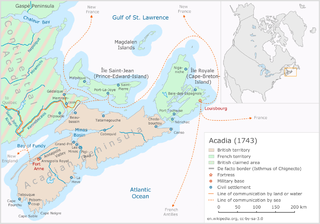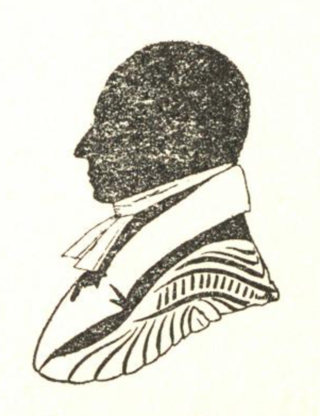Tatamagouche is a village in Colchester County, Nova Scotia, Canada.

Canso is a community in Guysborough County, on the north-eastern tip of mainland Nova Scotia, Canada, next to Chedabucto Bay. In January 2012, it ceased to be a separate town and as of July 2012 was amalgamated into the Municipality of the District of Guysborough.

Brigadier-General Charles Lawrence was a British military officer who, as lieutenant governor and subsequently governor of Nova Scotia, is perhaps best known for overseeing the Expulsion of the Acadians and settling the New England Planters in Nova Scotia. He was born in Plymouth, England, and died in Halifax, Nova Scotia. According to historian Elizabeth Griffiths, Lawrence was seen as a "competent", "efficient" officer with a "service record that had earned him fairly rapid promotion, a person of considerable administrative talent who was trusted by both Cornwallis and Hopson." He is buried in the crypt of St. Paul's Church (Halifax).

Annapolis Royal, formerly known as Port Royal, is a town located in the western part of Annapolis County, Nova Scotia, Canada.

The 84th Regiment of Foot (Royal Highland Emigrants) was a British regiment in the American Revolutionary War that was raised to defend present day Ontario, Quebec and Atlantic Canada from the constant land and sea attacks by American Revolutionaries. The 84th Regiment was also involved in offensive action in the Thirteen Colonies; including North Carolina, South Carolina, Georgia, Virginia and what is now Maine, as well as raids upon Lake Champlain and the Mohawk Valley. The regiment consisted of 2,000 men in twenty companies. The 84th Regiment was raised from Scottish soldiers who had served in the Seven Years' War and stayed in North America. As a result, the 84th Regiment had one of the oldest and most experienced officer corps of any regiment in North America. The Scottish Highland regiments were a key element of the British Army in the American Revolution. The 84th Regiment was clothed, armed and accoutred the same as the Black Watch, with Lieutenant Colonel Allan Maclean commanding the first battalion and Major General John Small of Strathardle commanding the second. The two Battalions operated independently of each other and saw little action together.

The Raid on Lunenburg occurred during the American Revolution when the US privateer, Captain Noah Stoddard of Fairhaven, Massachusetts, and four other privateer vessels attacked the British settlement at Lunenburg, Nova Scotia on July 1, 1782. The raid was the last major privateer attack on a Nova Scotia community during the war.

Father Le Loutre's War (1749–1755), also known as the Indian War, the Mi'kmaq War and the Anglo-Mi'kmaq War, took place between King George's War and the French and Indian War in Acadia and Nova Scotia. On one side of the conflict, the British and New England colonists were led by British officer Charles Lawrence and New England Ranger John Gorham. On the other side, Father Jean-Louis Le Loutre led the Mi'kmaq and the Acadia militia in guerrilla warfare against settlers and British forces. At the outbreak of the war there were an estimated 2500 Mi'kmaq and 12,000 Acadians in the region.

The Battle off Halifax took place on 28 May 1782 during the American Revolutionary War. It involved the American privateer Jack and the 14-gun Royal Naval brig HMS Observer off Halifax, Nova Scotia. Captain David Ropes commanded Jack, and Lieutenant John Crymes commanded Observer. The battle was "a long and severe engagement" in which Captain David Ropes was killed.

The Capture of HMS Savage was a naval battle of the American Revolutionary War involving the American privateer Congress and the British sloop-of-war HMS Savage. It occurred in September 1781 off South Carolina and is considered one of the hardest-fought single ship actions of the war.

HMS Surprise was a 28-gun Enterprise-class sixth-rate frigate of the Royal Navy, which served throughout the American Revolutionary War and was broken up in 1783.

Nova Scotia is a Canadian province located in Canada's Maritimes. The region was initially occupied by Mi'kmaq. The colonial history of Nova Scotia includes the present-day Canadian Maritime provinces and the northern part of Maine, all of which were at one time part of Nova Scotia. In 1763 Cape Breton Island and St. John's Island became part of Nova Scotia. In 1769, St. John's Island became a separate colony. Nova Scotia included present-day New Brunswick until that province was established in 1784. During the first 150 years of European settlement, the colony was primarily made up of Catholic Acadians, Maliseet and Mi'kmaq. During the latter seventy-five years of this time period, there were six colonial wars that took place in Nova Scotia. After agreeing to several peace treaties, this long period of warfare ended with the Halifax Treaties (1761) and two years later when the British defeated the French in North America (1763). During these wars, Acadians, Mi'kmaq and Maliseet from the region fought to protect the border of Acadia from New England. They fought the war on two fronts: the southern border of Acadia, which New France defined as the Kennebec River in southern Maine. The other front was in Nova Scotia and involved preventing New Englanders from taking the capital of Acadia, Port Royal, establishing themselves at Canso.

Captain Noah Stoddard (1755–1850) of Fairhaven, Massachusetts was an American privateer who distinguished himself during the American Revolution by leading the Raid on Lunenburg (1782). In the raid, Stoddard led four other privateer vessels and attacked the British settlement at Lunenburg, Nova Scotia on July 1, 1782. In Nova Scotia, the assault on Lunenburg was the most spectacular raid of the war.

HMS Blonde was a 32-gun fifth-rate warship of the British Royal Navy captured from the French in 1760. The ship wrecked on Blonde Rock with American prisoners on board. An American privateer captain, Daniel Adams, rescued the American prisoners and let the British go free. The captain's decision created an international stir. Upon returning to Boston, the American privateer was banished for letting go the British crew and he and his family became Loyalist refugees in Nova Scotia.
The raid on Demerara and Essequibo took place between 24 and 27 February 1781 in the context of the Fourth Anglo-Dutch War (1780–1784). Six British privateers entered the rivers and captured 15 Dutch vessels before withdrawing.

The Raid on Annapolis Royal took place on 29 August 1781 during the American Revolutionary War. The raid involved two American privateers - the Resolution and the Reprisal - attacking and pillaging Annapolis Royal, Nova Scotia in revenge of the defeat of the Penobscot Expedition. The privateers took captive the commander of the militia John Ritchie, described as the "Governor of Annapolis." One historian described it as "one of the most daring and dramatic raids upon Nova Scotia."

The Raid on Charlottetown of 17–18 November 1775, early in the American Revolutionary War, involved two American privateers of the Marblehead Regiment attacking and pillaging Charlottetown, Prince Edward Island, then known as St. John's Island. The raid motivated Nova Scotia Governor Francis Legge to declare martial law. Despite the raid's success, George Washington immediately freed senior colonial officials the privateers had brought back as prisoners to Cambridge, Massachusetts.

The Raid on Saint John took place on 27 August 1775 during the American Revolutionary War. The raid involved American privateers from Machias, Maine attacking Saint John, Nova Scotia. The privateers intended to stop the export of supplies being sent to the loyalists in Boston. This raid was the first hostile act committed against Nova Scotia and it resulted in raising the militia across the colony.
The Raid on Yarmouth took place on 5 December 1775 during the American Revolutionary War. The raid involved American Privateers from Salem, Massachusetts attacking Yarmouth, Nova Scotia at Cape Forchu. The privateers intended to stop the export of supplies being sent from Nova Scotia to the loyalists in Boston.

The Province of Nova Scotia was heavily involved in the American Revolutionary War (1776–1783). At that time, Nova Scotia also included present-day New Brunswick until that colony was created in 1784. The Revolution had a significant impact on shaping Nova Scotia, "almost the 14th American Colony". At the beginning, there was ambivalence in Nova Scotia over whether the colony should join the Americans in the war against Britain. Largely as a result of American privateer raids on Nova Scotia villages, as the war continued, the population of Nova Scotia solidified their support for the British. Nova Scotians were also influenced to remain loyal to Britain by the presence of British military units, judicial prosecution by the Nova Scotia Governors and the efforts of Reverend Henry Alline.

Captain David Ropes was a notable American Privateer from Salem, Massachusetts who fought in numerous naval battles during the American Revolution. He was taken prisoner twice during the war and then killed in the Battle off Halifax (1782).















